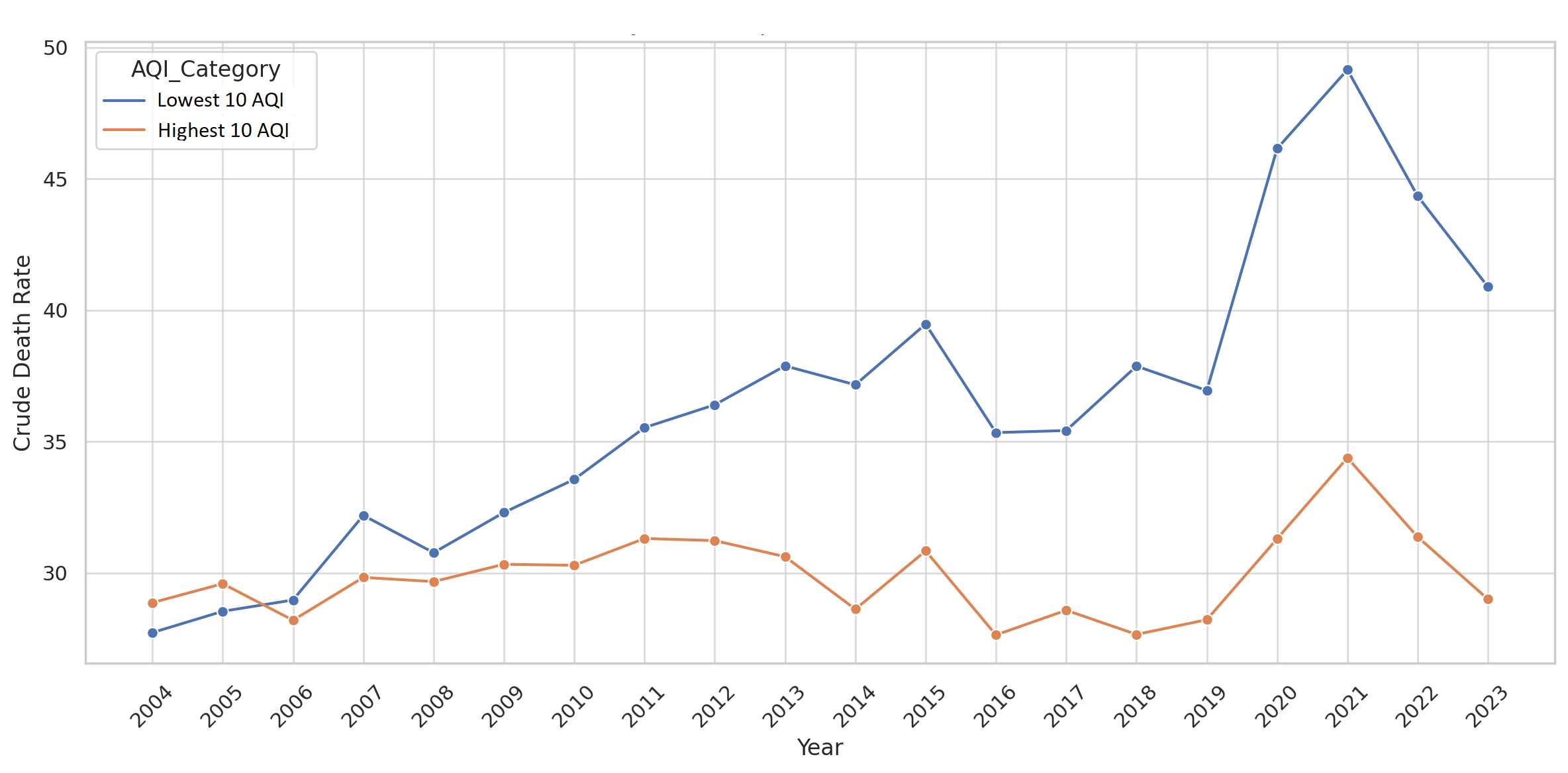Sunday Poster Session
Category: Liver
P1628 - Clean Air, Higher Mortality? A Paradoxical Trend in Liver-Related Deaths Across US States: A Longitudinal Analysis Using CDC WONDER and EPA AQS Databases (2004-2023)
Sunday, October 26, 2025
3:30 PM - 7:00 PM PDT
Location: Exhibit Hall

Avinash Nankani, MBBS (he/him/his)
Dow University of Health Sciences
Karachi, Sindh, Pakistan
Presenting Author(s)
Abdus Sameey Anwar, MBBS1, Amna Tasneem, MBBS2, Atika Tahreem, MBBS3, Sunny Kumar, MD4, Osama Abdur Rehman, MD5, Fnu Aakash, MD5, Aasta Kumari, MD6, Avinash Nankani, MBBS7, Rahul Kumar, MD8
1College of Medical Sciences, Bharatpur, Dhanbad, Jharkhand, India; 2Lady Hardinge Medical College, Delhi, New Delhi, Delhi, India; 3Hamdard Institute of Medical Sciences and Research, Delhi, New Delhi, Delhi, India; 4Wright Center for Graduate Medical Education, Scranton, PA; 5Florida State University, Cape Coral, FL; 6North Central Bronx Hospital, New York, NY; 7Dow University of Health Sciences, Karachi, Sindh, Pakistan; 8North Central Bronx Hospital, Bronx, NY
Introduction: Air pollution has been implicated in hepatic inflammation and progression of chronic liver diseases. However, real world data on the impact of ambient air quality on liver related mortality is sparse. This study examines the relationship between air quality and liver mortality among older adults across U.S. states from 2004 to 2023.
Methods: Non-infectious liver related crude death rates (per 100,000) of age group 45-54 years were obtained from the CDC WONDER Multiple Cause of Death database. Median annual Air Quality Index (AQI) data were retrieved from the U.S. EPA AQS database. Data sets were refined, organized and merged by state and year. We performed correlation (Pearson and Spearman) and linear regression analyses to assess associations. States were stratified by AQI into highest 10 (worst air quality) and lowest 10 (best air quality). Non-parametric tests (Mann-Whitney U) were used to compare mortality differences across AQI strata.
Results: Contrary to expectations, median AQI was negatively correlated with liver-related mortality (Pearson r = -0.17, p < 0.0001). Linear regression showed each unit increase in AQI was associated with a 0.29 decrease in crude liver death rate (β = -0.29, p < 0.0001; R² = 0.03). States with the worst AQI (e.g., California, Delaware) had lower average mortality (mean = 29.88/100,000), while the cleanest-air states (e.g., Montana, Hawaii) had higher mortality (mean = 36.33/100,000). The mortality difference between AQI groups was statistically significant (p < 0.001) and this inverse pattern persists for many years.
Discussion: This study reveals a paradoxical inverse association between air pollution and liver-related mortality across the states. This trend highlights the strong influence of unmeasured confounders such as healthcare access, substance use patterns and urban vs. rural disparities. These findings raise critical questions for aging population making residential decisions based on perceived air pollution levels and environmental quality.

Figure: Liver Related Mortality Trends between Highest AQI states vs Lowest AQI states (Low AQI is cleaner air)

Figure: Scatter Plot with Regression Line of AQI vs Crude Death Rate and Heat Map showing yearly correlation
Disclosures:
Abdus Sameey Anwar indicated no relevant financial relationships.
Amna Tasneem indicated no relevant financial relationships.
Atika Tahreem indicated no relevant financial relationships.
Sunny Kumar indicated no relevant financial relationships.
Osama Abdur Rehman indicated no relevant financial relationships.
Fnu Aakash indicated no relevant financial relationships.
Aasta Kumari indicated no relevant financial relationships.
Avinash Nankani indicated no relevant financial relationships.
Rahul Kumar indicated no relevant financial relationships.
Abdus Sameey Anwar, MBBS1, Amna Tasneem, MBBS2, Atika Tahreem, MBBS3, Sunny Kumar, MD4, Osama Abdur Rehman, MD5, Fnu Aakash, MD5, Aasta Kumari, MD6, Avinash Nankani, MBBS7, Rahul Kumar, MD8. P1628 - Clean Air, Higher Mortality? A Paradoxical Trend in Liver-Related Deaths Across US States: A Longitudinal Analysis Using CDC WONDER and EPA AQS Databases (2004-2023), ACG 2025 Annual Scientific Meeting Abstracts. Phoenix, AZ: American College of Gastroenterology.
1College of Medical Sciences, Bharatpur, Dhanbad, Jharkhand, India; 2Lady Hardinge Medical College, Delhi, New Delhi, Delhi, India; 3Hamdard Institute of Medical Sciences and Research, Delhi, New Delhi, Delhi, India; 4Wright Center for Graduate Medical Education, Scranton, PA; 5Florida State University, Cape Coral, FL; 6North Central Bronx Hospital, New York, NY; 7Dow University of Health Sciences, Karachi, Sindh, Pakistan; 8North Central Bronx Hospital, Bronx, NY
Introduction: Air pollution has been implicated in hepatic inflammation and progression of chronic liver diseases. However, real world data on the impact of ambient air quality on liver related mortality is sparse. This study examines the relationship between air quality and liver mortality among older adults across U.S. states from 2004 to 2023.
Methods: Non-infectious liver related crude death rates (per 100,000) of age group 45-54 years were obtained from the CDC WONDER Multiple Cause of Death database. Median annual Air Quality Index (AQI) data were retrieved from the U.S. EPA AQS database. Data sets were refined, organized and merged by state and year. We performed correlation (Pearson and Spearman) and linear regression analyses to assess associations. States were stratified by AQI into highest 10 (worst air quality) and lowest 10 (best air quality). Non-parametric tests (Mann-Whitney U) were used to compare mortality differences across AQI strata.
Results: Contrary to expectations, median AQI was negatively correlated with liver-related mortality (Pearson r = -0.17, p < 0.0001). Linear regression showed each unit increase in AQI was associated with a 0.29 decrease in crude liver death rate (β = -0.29, p < 0.0001; R² = 0.03). States with the worst AQI (e.g., California, Delaware) had lower average mortality (mean = 29.88/100,000), while the cleanest-air states (e.g., Montana, Hawaii) had higher mortality (mean = 36.33/100,000). The mortality difference between AQI groups was statistically significant (p < 0.001) and this inverse pattern persists for many years.
Discussion: This study reveals a paradoxical inverse association between air pollution and liver-related mortality across the states. This trend highlights the strong influence of unmeasured confounders such as healthcare access, substance use patterns and urban vs. rural disparities. These findings raise critical questions for aging population making residential decisions based on perceived air pollution levels and environmental quality.

Figure: Liver Related Mortality Trends between Highest AQI states vs Lowest AQI states (Low AQI is cleaner air)

Figure: Scatter Plot with Regression Line of AQI vs Crude Death Rate and Heat Map showing yearly correlation
Disclosures:
Abdus Sameey Anwar indicated no relevant financial relationships.
Amna Tasneem indicated no relevant financial relationships.
Atika Tahreem indicated no relevant financial relationships.
Sunny Kumar indicated no relevant financial relationships.
Osama Abdur Rehman indicated no relevant financial relationships.
Fnu Aakash indicated no relevant financial relationships.
Aasta Kumari indicated no relevant financial relationships.
Avinash Nankani indicated no relevant financial relationships.
Rahul Kumar indicated no relevant financial relationships.
Abdus Sameey Anwar, MBBS1, Amna Tasneem, MBBS2, Atika Tahreem, MBBS3, Sunny Kumar, MD4, Osama Abdur Rehman, MD5, Fnu Aakash, MD5, Aasta Kumari, MD6, Avinash Nankani, MBBS7, Rahul Kumar, MD8. P1628 - Clean Air, Higher Mortality? A Paradoxical Trend in Liver-Related Deaths Across US States: A Longitudinal Analysis Using CDC WONDER and EPA AQS Databases (2004-2023), ACG 2025 Annual Scientific Meeting Abstracts. Phoenix, AZ: American College of Gastroenterology.
